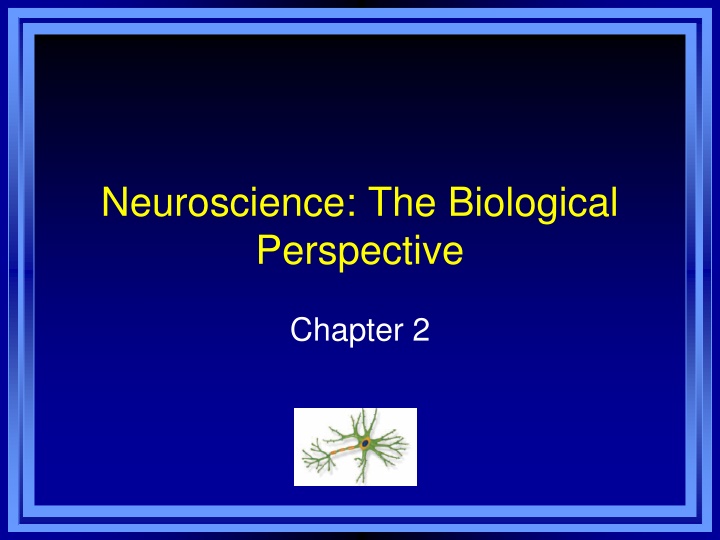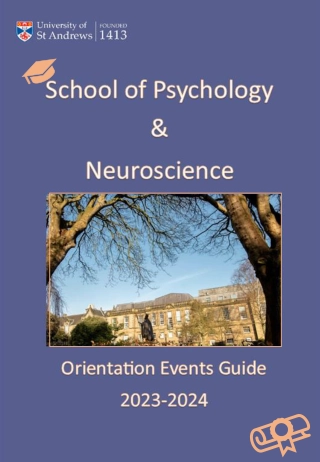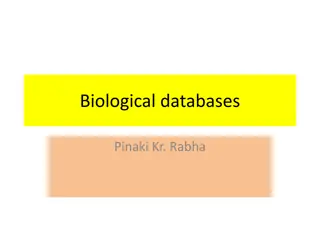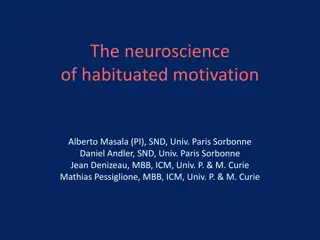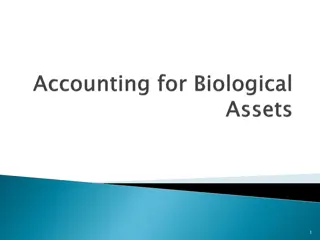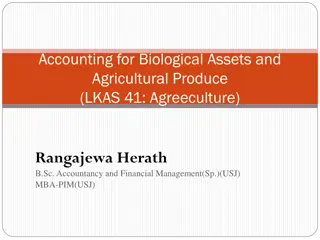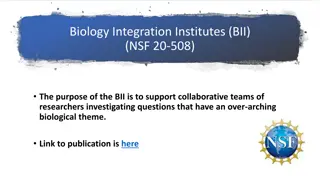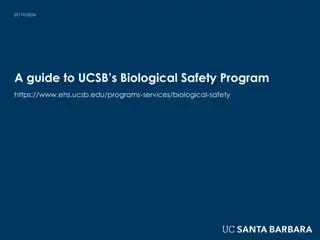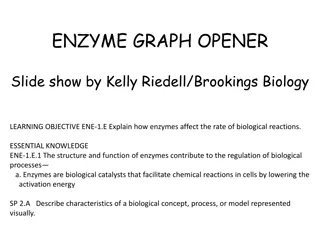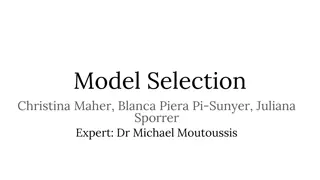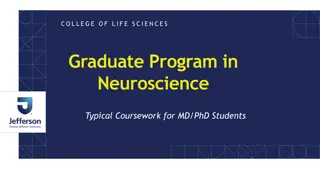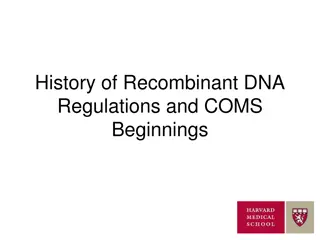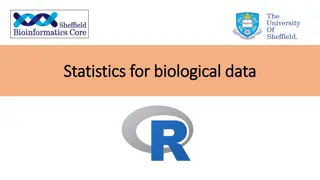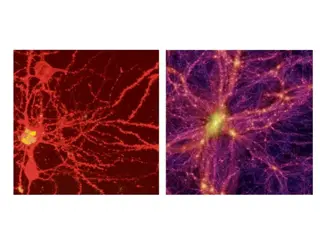Neuroscience: The Biological Perspective
In this chapter of neuroscience, explore the structure and function of neurons, nerves, and nervous tissue in relation to behavior and learning. Dive into the overview of the nervous system, the structure of neurons, different brain cells, neural impulse generation, and message transmission within the nervous system.
Download Presentation

Please find below an Image/Link to download the presentation.
The content on the website is provided AS IS for your information and personal use only. It may not be sold, licensed, or shared on other websites without obtaining consent from the author.If you encounter any issues during the download, it is possible that the publisher has removed the file from their server.
You are allowed to download the files provided on this website for personal or commercial use, subject to the condition that they are used lawfully. All files are the property of their respective owners.
The content on the website is provided AS IS for your information and personal use only. It may not be sold, licensed, or shared on other websites without obtaining consent from the author.
E N D
Presentation Transcript
Neuroscience: The Biological Perspective Chapter 2
Overview of Nervous System Nervous System - an extensive network of specialized cells that carry information to and from all parts of the body. Neuroscience deals with the structure and function of neurons, nerves, and nervous tissue. Relationship to behavior and learning.
Structure of the Neuron Neurons - the basic cell that makes up the nervous system and which receives and sends messages within that system. Parts of a Neuron Dendrites Soma Axon
Other Types of Brain Cells ___________- grey fatty cells that: provide support for the neurons to grow on and around, deliver nutrients to neurons, produce myelin to coat axons, Myelin - fatty substances produced by certain glial cells that coat the axons of neurons to insulate, protect, and speed up the neural impulse. clean up waste products and dead neurons.
Generating the Message: Neural Impulse Ions charged particles. Inside neuron negatively charged. Outside neuron positively charged. Resting potential - the state of the neuron when not firing a neural impulse. Action potential - the release of the neural impulse consisting of a reversal of the electrical charge within the axon. Allows positive sodium ions to enter the cell. All-or-none - referring to the fact that a neuron either fires completely or does not fire at all.
Sending the Message to Other Cells Axon terminals - branches at the end of the axon. ___________ rounded areas on the end of axon terminals. _____________- sack-like structures found inside the synaptic knob containing chemicals. ______________ - chemical found in the synaptic vesicles which, when released, has an effect on the next cell.
Sending the Message to Other Cells Synapse/synaptic gap - ____________ ________between the rounded areas on the end of the axon terminals of one cell and the dendrites or surface of the next cell. Receptor sites - areas in the surface of the dendrites or certain cells of the muscles and glands, which are shaped to fit only certain neurotransmitters.
Neuron Communication Neurons must be turned ON and OFF. Excitatory Inhibitory Chemical substances (drugs, etc.) can affect neuronal communication. Agonists - mimic or enhance the effects of a neurotransmitter on the receptor sites of the next cell, increasing or decreasing the activity of that cell. Antagonists - block or reduce a cell s response to the action of other chemicals or neurotransmitters.
Cleaning up the Synapse Reuptake - process by which neurotransmitters are taken back into the synaptic vesicles. Enzyme - a complex protein that is manufactured by cells.
Central Nervous System Central nervous system (CNS) - part of the nervous system consisting of the brain and spinal cord. Spinal cord - a long bundle of neurons that carries messages to and from the body to the brain that is responsible for very fast, lifesaving reflexes.
The Reflex Arc: Three Types of Neurons Sensory neuron - a neuron that carries information from the senses to the central nervous system. Motor neuron - a neuron that carries messages from the central nervous system to the muscles of the body. Interneuron - a neuron found in the center of the spinal cord that receives information from the sensory neurons and sends commands to the muscles through the motor neurons.
Peripheral Nervous System Peripheral nervous system (PNS) - all nerves and neurons that are not contained in the brain and spinal cord but that run through the body itself; divided into the: Somatic nervous system Autonomic nervous system
Somatic Nervous System Somatic nervous system - division of the PNS consisting of nerves that carry information from the senses to the CNS and from the CNS to the voluntary muscles of the body. Sensory pathway - nerves coming from the sensory organs to the CNS consisting of sensory neurons. Motor pathway - nerves coming from the CNS to the voluntary muscles, consisting of motor neurons.
Autonomic Nervous System Autonomic nervous system (ANS) - division of the PNS consisting of nerves that control all of the involuntary muscles, organs, and glands sensory pathway nerves coming from the sensory organs to the CNS consisting of sensory neurons. Sympathetic division (fight-or-flight system) Parasympathetic division -
Autonomic Parasympathetic functions (calming) Slows heart rate Constricts bronchi Increases digestive system function to normal Constricts pupils and inhibits tear glands Increases salivation Allows bladder contraction Sympathetic functions (excitatory) Increases heart rate Dilates bronchi Decreases digestive system function Dilates pupils Decreases salivation Inhibits bladder contraction
The Brain Stem Medulla - the first large swelling at the top of the spinal cord, forming the lowest part of the brain, which is responsible for life- sustaining functions such as breathing, swallowing, and heart rate. Pons - the larger swelling above the medulla that connects the top of the brain to the bottom and that plays a part in sleep, dreaming, left right body coordination, and arousal.
The Brain Stem Reticular formation (RF) - an area of neurons running through the middle of the medulla and the pons and slightly beyond that is responsible for selective attention. Cerebellum - part of the lower brain located behind the pons that controls and coordinates involuntary, rapid, fine motor movement.
Structures Under the Cortex Limbic system - a group of several brain structures located under the cortex and involved in learning, emotion, memory, and motivation. Thalamus - part of the limbic system located in the center of the brain, this structure relays sensory information from the lower part of the brain to the proper areas of the cortex and processes some sensory information before sending it to its proper area. Olfactory bulbs - two projections just under the front of the brain that receive information from the receptors in the nose located just below.
Structures Under the Cortex Limbic system (continued) Hypothalamus - small structure in the brain located below the thalamus and directly above the pituitary gland, responsible for motivational behavior such as sleep, hunger, thirst, and sex. Sits above and controls the pituitary gland (master endocrine gland). Hippocampus - curved structure located within each temporal lobe, responsible for the formation of long-term memories and the storage of memory for location of objects. Amygdala - brain structure located near the hippocampus, responsible for fear responses and memory of fear.
Cortex Cortex - outermost covering of the brain consisting of densely packed neurons, responsible for higher thought processes and interpretation of sensory input. Corticalization wrinkling of the cortex. Allows a much larger area of cortical cells to exist in the small space inside the skull.
Cerebral Hemispheres Cerebral hemispheres - the two sections of the cortex on the left and right sides of the brain. Corpus callosum - thick band of neurons that connects the right and left cerebral hemispheres.
Four Lobes of the Brain Occipital lobe - section of the brain located at the rear and bottom of each cerebral hemisphere containing the visual centers of the brain. Primary visual cortex processes visual information from the eyes. Visual association cortex identifies and makes sense of visual information. Parietal lobes - sections of the brain located at the top and back of each cerebral hemisphere containing the centers for touch, taste, and temperature sensations. Somatosensory cortex - area of neurons running down the front of the parietal lobes responsible for processing information from the skin and internal body receptors for touch, temperature, body position, and possibly taste.
Four Lobes of the Brain Temporal lobes - areas of the cortex located just behind the temples containing the neurons responsible for the sense of hearing and meaningful speech. Primary auditory cortex processes auditory information from the ears. Auditory association cortex identifies and makes sense of auditory information. Frontal lobes - areas of the cortex located in the front and top of the brain, responsible for higher mental processes and decision making as well as the production of fluent speech. Motor cortex - section of the frontal lobe located at the back, responsible for sending motor commands to the muscles of the somatic nervous system.
Language is primarily a left hemisphere activity for most individuals
Results of Split Brain Research Left side of the brain: seems to control language, writing, logical thought, analysis, and mathematical abilities, processes information sequentially, can speak. Right side of the brain controls emotional expression, spatial perception, recognition of faces, patterns, melodies, and emotions, processes information globally, cannot speak.
The Endocrine Glands Endocrine glands - glands that secrete chemicals called hormones directly into the bloodstream. Hormones - chemicals released into the bloodstream by endocrine glands. Pituitary gland - gland located in the brain that secretes human growth hormone and influences all other hormone-secreting glands (also known as the master gland). Pineal gland - endocrine gland located near the base of the cerebrum that secretes melatonin. Thyroid gland - endocrine gland found in the neck that regulates metabolism. Pancreas - endocrine gland that controls the levels of sugar in the blood.
The Endocrine Glands Gonads - the sex glands that secrete hormones that regulate sexual development and behavior as well as reproduction. Ovaries - the female gonads. Testes - the male gonads. Adrenal glands - endocrine glands located on top of each kidney that secrete over 30 different hormones to deal with stress, regulate salt intake, and provide a secondary source of sex hormones affecting the sexual changes that occur during adolescence.
